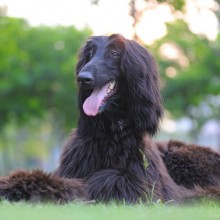Afghan Hound
Lifestyle Needs

The Afghan Hound is a large sight hound with a very long, silky coat. His original function was to hunt and he may well give chase to any small animal if given the chance. Basic training in obedience and recall is essential with this dog. The Afghan is a glamorous and rather aloof dog who will become very attached to his owner. He needs to live in a large house with a large garden and be given at least two hours exercise every day. His excessive coat will require careful grooming every day to keep it clean and avoid tangles.
Genetic Diversity
(Known as Coefficient of Inbreeding: 'COI'. It should be as low as possible.)
The UK Kennel Club breed average COI is 7.7% - See 'A Beginners Guide to COI'
Gene Pool Size
(Known as Effective Population Size: 'EPS')
245.1
EPS is a measure of how many individuals are contributing genetically to a breed population. It is a measure of the size of the gene pool in a breed. Lower than 100 is considered critical by conservationists and below 50 brings a breed close to extinction. For more information see the Kennel Club article.
Health and Welfare Problems due to Conformation
(Body shape and physical characteristics)
- The very long and silky coat will cause welfare problems if it isn’t given the grooming time and care it needs. Hair will obscure the dogs’ vision and collect dirt and debris which in turn could cause skin problems.
- Medial canthal pocket syndrome (due to head shape)
BVA/KC Health Schemes: www.bva.co.uk/chs
- Hip dysplasia: breed 5 year mean score 14.7 (ideally parents should be lower)
Estimated Breeding Values (EBVs) : No EBVs are currently available for this breed
www.thekennelclub.org.uk/about-ebvs
DNA Tests Available
DogWellNet and IPFD Harmonisation of Genetic Testing for Dogs (HGTD)
www.dogwellnet.com/breeds
Availability of a DNA test does not mean that it is always necessary or even desirable for breeders to use this test.
Other Breed-Specific Health Screening Schemes
None known
Ask the breeder to show you the certificates for the above tests/screening for both parents. If any of the above tests have not been considered necessary by the breeder (and there may be good reasons), ask her to explain why.
Other Diseases Reported
(For which there are currently no genetic or screening tests for sire or dam)
- Gastric dilatation volvulus (GDV) (Bloat or Gastric torsion)
- Afghan Hound myelopathy
- Laryngeal paralysis
- Lung lobe torsion
- Panosteitis
- Hypothyroidism
- Mucopolysaccharidosis 1 (MPS 1)
- Cancer: Perianal gland tumour, mammary tumour, skin tumour
Ask the breeder about the medical history of the parents, grandparents and great grandparents. Consider carefully whether to purchase a puppy if some of these or other diseases are in the family line.
Ask about the breeder’s policy in cases of serious genetic diseases occurring to your puppy in later life. Good breeders will request to be informed of such events in order to improve future breeding decisions.
You are strongly advised to buy from a breeder who uses (or is prepared to use) the AWF Puppy Contract and Puppy Information Pack (PIP): www.puppycontract.org.uk
The breeder should also be familiar with the CFSG/DBRG Code of Practice for Dog Breeding